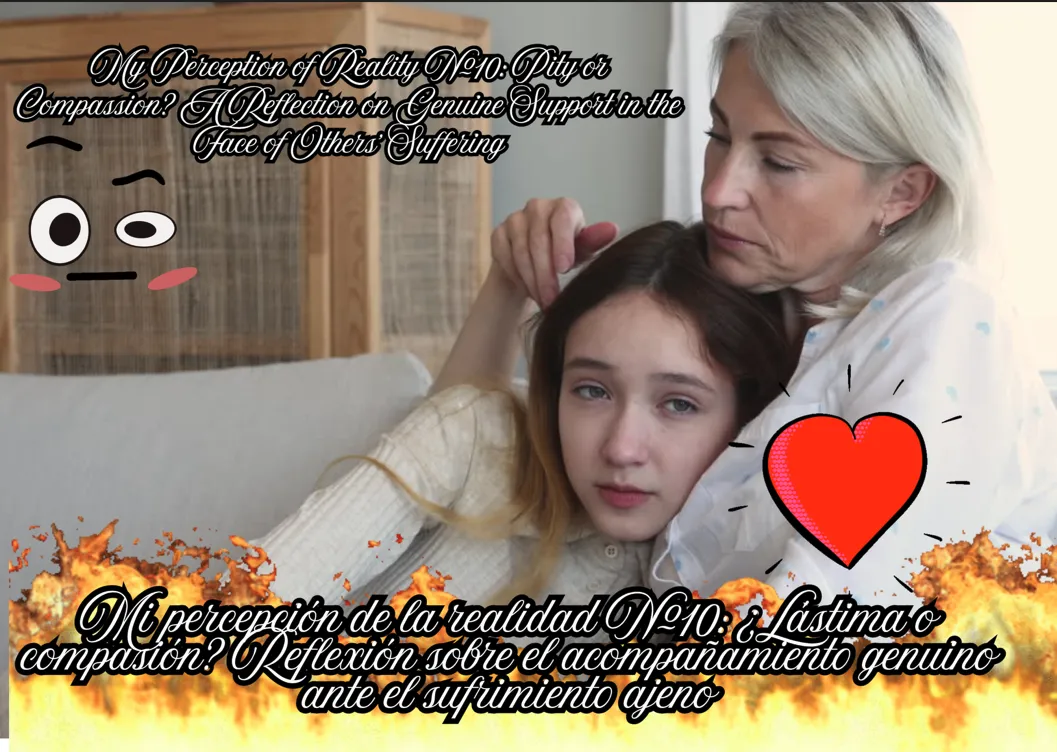
- ahora digo yo:
Entender este sentimiento es un poco complejo, la lástima es un sentimiento de tristeza por medio del sufrimiento de otra persona, donde se suele esperar que la situación mejore, sin actuar, en algunas situaciones es donde utilizamos frases como “Pobrecito, Qué desgracia” o un sinfín de enunciados que son frecuentes en nuestro vocablo, por lo general cuando sentimos lástima por alguna persona, tendemos a notarlo internamente y sin darnos cuenta como víctima o incapaz de poder solventar su situación, en algunas situaciones cuando se hace notar por la persona afectada genera impotencia ante la situación; sin embargo, cuando ayudamos de manera positiva podemos llamar compasión a ese sentimiento.

¿Pero no son lo mismo?, pues no, la compasión implica casi los mismos sentimientos, pero de manera más intensa, implica una empatía profunda, donde podemos comprender y compartir el dolor de otro con un deseo genuino de aliviar ese sufrimiento, actuando en hechos y no solo en palabras y pensamientos.
Cuando lo notamos a nivel psicológico, la compasión o el acto de ser compasivo se fundamenta en el reconocimiento fundamental de igualdad de las personas, no hay ninguna superioridad, sino la identificación profunda en el ser, donde nosotros decidimos ayudar haciéndonos la visión de que “Eso me puede pasar”.
El acto de ser compasivo tiende a movilizar la acción de nosotros, y la fomentación de las relaciones más cercanas basadas en el apoyo mutuo, promoviendo el crecimiento, la superación y la resiliencia en todo momento de la vida, para poder ampliar la expectativa de superarse de la persona.
Ya conociendo esto también podemos tocar un pequeño tema que es parte de una realidad y es cuando la compasión se convierte en abuso por medio de las personas que quieren dar lástima; y si el juego con los sentimientos humanos es algo tan normal como respirar.
Cuando existe el sentimiento de lástima en algunos casos, genera dependencia emocional y refuerza el papel de la víctima, generando una piedra en un morral invisible para el que se siente mal por la situación y como dirían algunas personas “lloremos juntos”, pero a la final no solventarán nada si actúan de esta manera, además de denotar superioridad para el que siente la lástima y esto no es algo muy sano que digamos.
Sin embargo, cuando se presenta el sentimiento de compasión se ve favorecido directamente el bienestar emocional, apoyando de esta manera tanto al que recibe, como al que promueve la relación saludable basada en el respeto mutuo y el apoyo, de igual manera para superar las dificultades de la vida, todo con el fin de superar y no convertir el acto de la compasión en un círculo vicioso de lástima.
En síntesis mis queridos lectores, podríamos decir que la lástima puede hacer sentir poca cosa, o inferior a la persona que sufre, sin embargo, mientas que la compasión promueve el vínculo de superación mutua y ese sentido de que vamos a salir de esto si nos lo proponemos; podríamos decir que la lastima y la compasión parten de un origen común, que es el sentimiento de dolor ajeno, pero todo depende la actitud como ejecutemos la acción para definir si sentimos lástima o compasión por la persona claramente ayudada, siendo la compasión algo más sano y correcto para la superación de esa persona.
Como consejo puedo decir que practiquemos el autoconocimiento de nosotros mismos para evitar caer en la equivocación de sentir lástima en vez de compasión, además de la práctica de la empatía para comprender, sin juzgar, reconociendo la igualdad de aquella persona con nosotros.
Además, debemos cambiar nuestro foco de atención hacia un objetivo positivo, es decir no solo enfocarnos en buscar el dolor o la desgracia del otro, sino más bien buscar las cualidades que lo definen como persona, para cultivar el apoyo genuino, expresando de esta manera la compasión con acciones concretas de manera amable, ofreciendo una postura amable y respetuosa para generar un vínculo de apoyo real, evitando la dependencia que genera la lástima.
Para finalizar debemos cultivar la paciencia y la constancia, trabajando con tiempo y dedicación, reflexionando sobre la manera más efectiva para lograr el objetivo mutuo sin ser dependientes el uno del otro.
Como nota personal puedo decir que en mi vida cuando sentía lástima trataba de ayudar muchísimo a la persona entregando todo lo que podía, pero a la final esa persona abusaba y terminaba yo afectado, tanto monetaria como psicológicamente, ahora veo, analizo y pienso como puedo hacerlo, porque para ayudar a los demás primero debemos conocernos a nosotros mismos, Cuestión de no caer en el error de llorar juntos de por vida y no solventar nada, o peor aún de caer en la manipulación psicológica “que esto será tema para un próximo escrito mis amigos”.
Imagenes creadas con canvas.
ENGLISH

Pity is a feeling that all of us have experienced at some point in our lives due to various factors, from personal to collective. It can be said that pity is one of the most common feelings in life, yet also one of the most complex and misunderstood. It is a fusion of many emotions, such as sorrow and sadness, arising from witnessing the suffering of someone or something in a given moment. This feeling is intertwined with empathy and involves understanding the pain of others, which sometimes comes with the urge to alleviate their suffering.
Now, I say: Understanding this feeling is somewhat complex. Pity is a feeling of sadness through another person’s suffering, where one usually hopes the situation improves—without taking action. In some situations, we use phrases like “Poor thing, what a tragedy,” or countless similar expressions that are common in our vocabulary. Generally, when we feel pity for someone, we internally perceive them—often unconsciously—as a victim or as someone incapable of resolving their situation. If the suffering person becomes aware of it, they may experience helplessness. However, when we offer positive help, the feeling can be called compassion.
But aren’t pity and compassion the same? Not quite. Compassion involves nearly the same emotions but on a more intense level. It reflects deep empathy, allowing us to understand and share someone else's pain with a sincere desire to ease it—acting not only through words and thoughts, but also through deeds.
From a psychological standpoint, compassion or the act of being compassionate is based on recognizing the fundamental equality of people. It is not about superiority but rather about deep identification with the other person, seeing their situation as something that could happen to us.
Being compassionate motivates action and fosters close relationships based on mutual support, promoting growth, overcoming adversity, and resilience in all moments of life. It expands a person’s ability to rise above their challenges.
Understanding this, we can also touch on a real issue—when compassion becomes a tool for manipulation by those who seek pity. Playing with human emotions is unfortunately as normal as breathing.
In some cases, pity creates emotional dependence and reinforces the victim role. It becomes a burden for the one who feels bad and, as some might say, “Let’s cry together.” But ultimately, nothing gets resolved if we stay stuck in that mindset. Moreover, it often gives the person feeling pity a sense of superiority—which is not healthy.
Compassion, on the other hand, benefits emotional well-being. It helps both the receiver and the person offering support by fostering healthy relationships based on respect and shared growth. It allows people to overcome difficulties without falling into a vicious cycle of pity.
In summary, my dear readers: pity can make the suffering person feel small or inferior, while compassion builds the bond of mutual growth and the feeling that we can overcome adversity together if we commit to it. Both emotions originate from sensing someone else’s pain, but our attitude determines whether we are feeling pity or compassion. Compassion is the healthier and more constructive response.
As a piece of advice, I would encourage practicing self-awareness so we don’t fall into the mistake of feeling pity instead of compassion. Empathy should also be cultivated to understand without judging, recognizing that the other person is our equal.
Additionally, we should shift our focus toward positive goals—not just concentrating on someone’s pain or misfortune, but recognizing their qualities and strengths. Doing so allows us to offer genuine support through kind, concrete actions and foster respectful, supportive relationships—avoiding the emotional dependence that pity can create.
Finally, let’s cultivate patience and perseverance, working with time and dedication, while reflecting on the most effective ways to achieve shared goals without becoming dependent on one another.
As a personal note, I can say that in my life, when I felt pity, I used to help as much as I could—giving everything. But in the end, people took advantage, and I would end up affected, both financially and emotionally. Now I observe, analyze, and reflect on how best to help. Because to truly help others, we first need to understand ourselves. Otherwise, we risk crying together endlessly and solving nothing—or worse, falling into psychological manipulation… which will be a topic for my next writing, my friends.